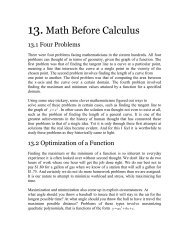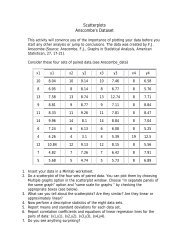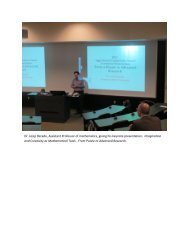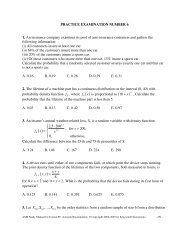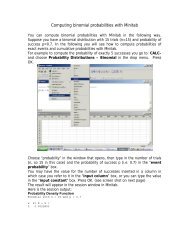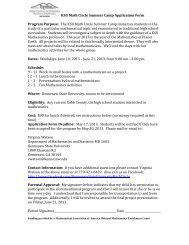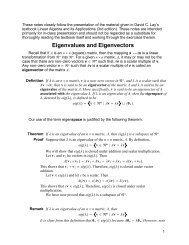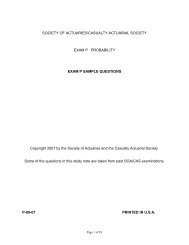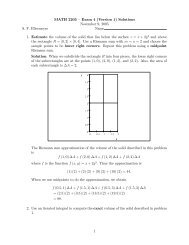EXAM P SAMPLE SOLUTIONS
EXAM P SAMPLE SOLUTIONS
EXAM P SAMPLE SOLUTIONS
Create successful ePaper yourself
Turn your PDF publications into a flip-book with our unique Google optimized e-Paper software.
64. Solution: A<br />
Let X denote claim size. Then E[X] = [20(0.15) + 30(0.10) + 40(0.05) + 50(0.20) +<br />
60(0.10) + 70(0.10) + 80(0.30)] = (3 + 3 + 2 + 10 + 6 + 7 + 24) = 55<br />
E[X 2 ] = 400(0.15) + 900(0.10) + 1600(0.05) + 2500(0.20) + 3600(0.10) + 4900(0.10)<br />
+ 6400(0.30) = 60 + 90 + 80 + 500 + 360 + 490 + 1920 = 3500<br />
2 2<br />
Var[X] = E[X ] – (E[X]) = 3500 – 3025 = 475 and Var[ X ] = 21.79 .<br />
Now the range of claims within one standard deviation of the mean is given by<br />
[55.00 – 21.79, 55.00 + 21.79] = [33.21, 76.79]<br />
Therefore, the proportion of claims within one standard deviation is<br />
0.05 + 0.20 + 0.10 + 0.10 = 0.45 .<br />
--------------------------------------------------------------------------------------------------------<br />
65. Solution: B<br />
Let X and Y denote repair cost and insurance payment, respectively, in the event the auto<br />
is damaged. Then<br />
⎧0<br />
if x ≤ 250<br />
Y = ⎨<br />
⎩x−<br />
250 if x><br />
250<br />
and<br />
2<br />
1500 1 1 2 1500 1250<br />
EY [ ] = ∫ ( x− 250) dx= ( x−<br />
250) 250 = = 521<br />
250 1500 3000 3000<br />
3<br />
1500<br />
2 1 2 1 3 1500 1250<br />
E⎡ ⎣Y ⎤<br />
⎦ = ∫ ( x− 250) dx= ( x−<br />
250) 250 = = 434,028<br />
250 1500 4500 4500<br />
2 [ Y] = E⎡Y ⎤−<br />
{ E[ Y]<br />
} = −(<br />
)<br />
[ Y ]<br />
2 2<br />
Var ⎣ ⎦<br />
434,028 521<br />
Var = 403<br />
--------------------------------------------------------------------------------------------------------<br />
66. Solution: E<br />
Let X1, X 2, X 3, and X4<br />
denote the four independent bids with common distribution<br />
function F. Then if we define Y = max (X1, X 2, X 3, X4),<br />
the distribution function G of Y is<br />
given by<br />
G( y) = Pr[<br />
Y ≤ y]<br />
= Pr ⎡⎣( X1 ≤ y) ∩( X2 ≤ y) ∩( X3 ≤ y) ∩( X4 ≤ y)<br />
⎤⎦<br />
= Pr X ≤ y Pr X ≤ y Pr X ≤ y Pr X ≤ y<br />
[ ] [ ] [ ] [ ]<br />
( )<br />
= ⎡⎣F y ⎤⎦<br />
1 2 3 4<br />
4<br />
1 4 3 5<br />
( π )<br />
= 1+ sin<br />
16<br />
y , ≤ y≤<br />
2 2<br />
It then follows that the density function g of Y is given by<br />
Page 27 of 55



